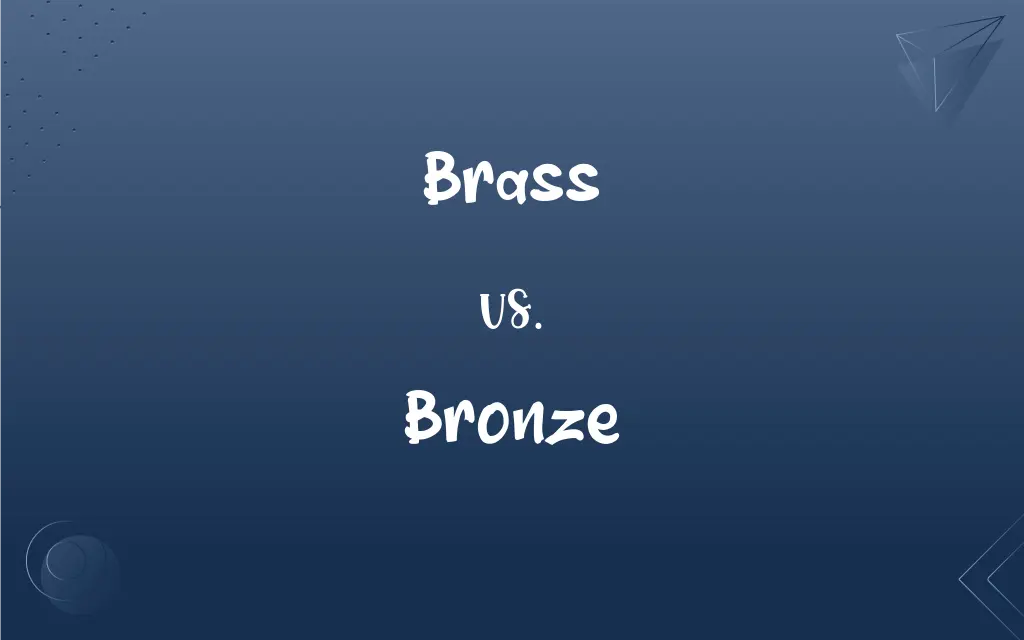Brass vs. Bronze: What's the Difference?
Edited by Aimie Carlson || By Harlon Moss || Updated on June 10, 2024
Brass is an alloy of copper and zinc; bronze is an alloy of copper and tin.

Key Differences
Brass and bronze are both alloys primarily made of copper, but they differ in their secondary components. Brass is primarily made from a combination of copper and zinc. In contrast, bronze is an alloy resulting from the combination of copper with tin, and sometimes other elements like phosphorus, manganese, aluminum, or silicon.
Color can also help distinguish between brass and bronze. Brass typically has a bright, somewhat yellowish appearance, similar to gold. On the other hand, bronze has a reddish-brown color, giving it an appearance closer to a subdued copper.
Both brass and bronze are used in a variety of applications, but their properties make them suitable for different purposes. Brass, with its bright appearance, is often used in decorative items, musical instruments like trumpets, and cartridge casings. Bronze, being more robust and less prone to corrosion, especially from saltwater, finds its use in sculptures, ship fittings, and ancient weapons.
In terms of hardness and durability, bronze tends to be harder and more durable than brass. This durability has made bronze a choice material for tools and weapons throughout history. Brass, while not as hard, has a lower melting point, making it easier to cast and mold, thus favoring its use in fittings and intricate designs.
Historically, the usage of both brass and bronze dates back thousands of years. Early civilizations recognized the benefits of alloying copper with other metals. While bronze, especially the variety with tin, was used extensively in ancient times for tools, armor, and art, brass gained prominence much later due to the ease of its production and malleability.
ADVERTISEMENT
Comparison Chart
Primary Components
Copper and zinc
Copper and tin
Color
Bright, gold-like, somewhat yellowish
Reddish-brown
Common Uses
Decorative items, musical instruments, cartridge casings
Sculptures, ship fittings, ancient weapons
Hardness & Durability
Less hard and durable
Harder and more durable
Historical Prevalence
Gained prominence later
Extensively used in ancient times
ADVERTISEMENT
Brass and Bronze Definitions
Brass
The cartridges or ammunition for firearms.
He loaded the brass into his rifle.
Bronze
A work of art, such as a statue, made of bronze.
The gallery had several bronzes on display.
Brass
A class of musical instruments, typically made of brass, that use buzzing lips to produce sound.
The brass section of the orchestra was exceptionally loud.
Bronze
A sun-tanned complexion or its cosmetic simulation.
She had a lovely bronze glow after her vacation.
Brass
A yellowish alloy of copper and zinc.
The door handle was made of shiny brass.
Bronze
To give something the appearance of bronze, especially in color.
She bronzed her shoes for a vintage look.
Brass
High-ranking military officers.
The brass ordered the troops to move forward.
Bronze
A reddish-brown alloy of copper and tin.
The statue was a beautiful work of bronze.
Brass
Slang for money.
He made a lot of brass with that deal.
Bronze
A third-place medal in sports or competitions.
She won the bronze in the 100-meter race.
Brass
A yellowish alloy of copper and zinc, sometimes including small amounts of other metals, but usually 67 percent copper and 33 percent zinc.
Bronze
Any of various alloys of copper and tin in various proportions, sometimes with traces of other metals.
Brass
Ornaments, objects, or utensils made of this alloy.
Bronze
Any of various alloys of copper, with or without tin, and antimony, phosphorus, or other components.
FAQs
Is brass harder than bronze?
No, bronze is generally harder than brass.
Which is primarily an alloy of copper and zinc?
Brass is primarily an alloy of copper and zinc.
What is the main metal combined with copper to make bronze?
Tin is combined with copper to make bronze.
Which alloy is often used in sculptures?
Bronze is often used in sculptures.
What's the melting point comparison between brass and bronze?
Brass has a lower melting point than bronze.
Which has a longer history of use, brass or bronze?
Bronze has a longer history of use compared to brass.
Is bronze only made of copper and tin?
Primarily, but other elements can be added to modify its properties.
Are bronze medals actually made of bronze?
Typically, yes, bronze medals are made of bronze.
Can the term "brass" refer to money?
Yes, in slang, "brass" can refer to money.
Which alloy is used more in decorative items?
Brass is often used more in decorative items.
In terms of cost, which is generally more expensive, brass or bronze?
The cost can vary based on factors like purity and market demand, but bronze is often more expensive than brass.
Which is more yellowish, brass or bronze?
Brass is more yellowish than bronze.
Why is bronze more corrosion-resistant, especially in saltwater?
The presence of tin in bronze increases its corrosion resistance.
Which is better for intricate designs, brass or bronze?
Brass is often preferred for intricate designs due to its malleability.
Does bronze age or tarnish over time?
Yes, bronze can develop a patina over time.
Which is preferred for making bullets or cartridges?
Brass is preferred for making bullets or cartridges.
What is the greenish layer that forms on bronze called?
The greenish layer is called patina.
Can "to bronze" mean to tan?
Yes, "to bronze" can mean to tan or give a tan appearance.
Are brass musical instruments actually made of brass?
Yes, brass instruments are typically made of brass.
What color is bronze?
Bronze is reddish-brown.
About Author
Written by
Harlon MossHarlon is a seasoned quality moderator and accomplished content writer for Difference Wiki. An alumnus of the prestigious University of California, he earned his degree in Computer Science. Leveraging his academic background, Harlon brings a meticulous and informed perspective to his work, ensuring content accuracy and excellence.
Edited by
Aimie CarlsonAimie Carlson, holding a master's degree in English literature, is a fervent English language enthusiast. She lends her writing talents to Difference Wiki, a prominent website that specializes in comparisons, offering readers insightful analyses that both captivate and inform.































































